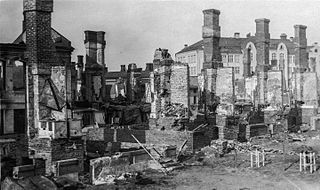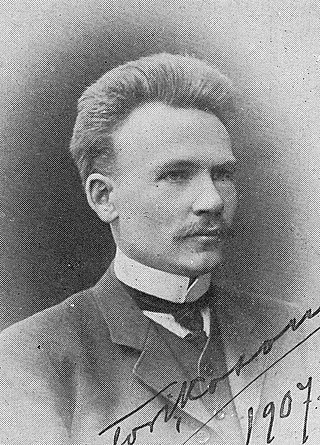
The transport system of Finland is well-developed. Factors affecting traffic include the sparse population and long distance between towns and cities, and the cold climate with waterways freezing and land covered in snow for winter.

The Finnish Civil War was a civil war in Finland in 1918 fought for the leadership and control of the country between White Finland and the Finnish Socialist Workers' Republic during the country's transition from a grand duchy ruled by the Russian Empire to a fully independent state. The clashes took place in the context of the national, political, and social turmoil caused by World War I in Europe. The war was fought between the Red Guards, led by a section of the Social Democratic Party, and the White Guards, conducted by the senate and those who opposed socialism with assistance late in the war by the German Imperial Army at the request of the Finnish civil government. The paramilitary Red Guards, which were composed of industrial and agrarian workers, controlled the cities and industrial centres of southern Finland. The paramilitary White Guards, which consisted of land owners and those in the middle and upper classes, controlled rural central and northern Finland, and were led by General C. G. E. Mannerheim.

Estonia is a relatively safe country, and the risk of being a victim of crime in Estonia is small by international standards. As in other post-Soviet states, crime has increased in the 1990s, but then it has gradually decreased in the 21st century.

Peter the Painter, also known as Peter Piaktow, was a member of a gang of immigrant Latvian anarchists in London in the early 20th century. After supposedly fighting in and escaping the Sidney Street Siege in 1911, he became an anti-hero in London's East End. He was never caught, and there is some question as to whether he had participated in the Sidney Street incident, or even whether he existed at all.

The Red Guards were the paramilitary units of the labour movement in Finland during the early 1900s. The Red Guards formed the army of Red Finland and were one of the main belligerents of the Finnish Civil War in 1918.
The West End Gang is a Canadian organized crime group in Montreal, Quebec. An Irish mob group originating from the Irish-Canadian ethnic enclave of Pointe-Saint-Charles in the 1950s, the majority of the gang's earnings were initially derived from truck hijackings, home invasions, kidnapping, protection rackets, extortion, and armed robbery, with its criminal activities focused on, but not restricted to, the west side of Montreal. The West End Gang came to prominence via a series of high-profile bank robberies between the 1950s and the 1970s, a period when Montreal was known as "Bank Robbery capital of North America". Due to the gang's control of illegal activity at the Port of Montreal, it moved into drug trafficking and became one of the most influential criminal organizations in Canada.

Although Finland has no dedicated high-speed rail lines, sections of its rail network are capable of running speeds of up to 220 km/h (137 mph). The Finnish national railway company VR operates tilting Alstom Pendolino trains. The trains reach their maximum speed of 220 km/h (137 mph) in regular operation on a 75.7 km (47.0 mi) route between Kerava and Lahti. This portion of track was opened in 2006. The trains can run at 200 km/h (124 mph) on a longer route between Helsinki and Seinäjoki and peak at that speed between Helsinki and Turku. The main railway line between Helsinki and Oulu has been upgraded between Seinäjoki and Oulu to allow for trains to run at speeds between 160 km/h (99 mph) and 200 km/h (124 mph). Other parts of the Finnish railway network are limited to lower speed.

Simon Arshaki Ter-Petrosian, better known by his nom de guerre of Kamo, was an Old Bolshevik revolutionary and an early companion to Soviet leader Joseph Stalin.
The Georgian Socialist-Federalist Revolutionary Party was a Georgian nationalist party, founded in April 1904. The party's program demanded the national autonomy of Georgia, within the framework of a Russian federal state, and advocated for a democratic socialist system. Mainly based in the rural areas, the party's membership was almost entirely drawn from the peasantry and the petty gentry. The political profile of the party had an appeal amongst moderately nationalist intellectuals, schoolteachers and students. The party strived that agricultural issues not be decided by central authorities, but by autonomous national institutions. The party published the periodical Sakartvelo.

The 1907 Tiflis bank robbery, also known as the Erivansky Square expropriation, was an armed robbery on 26 June 1907[a] in the city of Tiflis in the Tiflis Governorate in the Caucasus Viceroyalty of the Russian Empire. A Bolshevik group "expropriated" a bank cash shipment to fund their revolutionary activities. The robbers attacked a bank stagecoach, and the surrounding police and soldiers, using bombs and guns while the stagecoach was transporting money through Erivansky Square between the post office and the Tiflis branch of the State Bank of the Russian Empire. The attack killed forty people and injured fifty others, according to official archive documents. The robbers escaped with 241,000 rubles.

The Gardiner–Hall Gang was an informal group of bushrangers who roamed the central west of the Colony of New South Wales, Australia in the 1860s. Named after leaders Frank Gardiner and Ben Hall, the gang was involved in numerous shootouts and robberies, including Australia's largest ever gold robbery, at Eugowra Rocks. The gang formed in 1861 and its demise came with the execution of John Dunn in 1866.

Nikolay Yevgenyevich Burenin was a Russian Bolshevik revolutionary, writer, concert pianist and music collector who worked as an organizer and specialist for Bolshevik illegal operations. He was a member of the Union of Soviet Writers.

Tampere camp was a concentration camp operating from 6 April 1918 to 15 September 1918 in the Kaleva district of Tampere, Finland. It was set up for the Reds captured by the White Army after the Finnish Civil War Battle of Tampere.

All-female units of the paramilitary Red Guards served in the 1918 Finnish Civil War. The first Women's Guards units formed in early February in the main Finnish cities. More than 15 female Guards units were established by the end of March 1918, with a total of about 2,000 women serving. The female Guards units consisted of young industrial workers, maids, and servants. Their average age was about 20, but some were as young as 14. The women served in auxiliary units in combat.

Jānis Čoke was a Latvian revolutionary who is known for his involvement in the 1906 robbery of the branch of Russian State Bank in Helsinki.

Vihtori Kosonen (1873–1934) was a Finnish journalist, publisher, and free-thinker.
Lars Harnes is a Norwegian outlaw biker and gangster who served as the national president of the Bandidos Motorcycle Club in Norway.

The Bandidos Motorcycle Club is classified as a motorcycle gang by law enforcement and intelligence agencies in numerous countries. While the club has denied being a criminal organization, Bandidos members have been convicted of partaking in criminal enterprises including theft, extortion, prostitution, drug trafficking and murder in various host nations.
Anarchism in Finland dates back to the early revolutionary movements of the 20th century, seeing organized activity begin in the 1960s.

Matti Turkia was a Finnish newspaper editor, politician and member of the Parliament of Finland, the national legislature of Finland. A member of the Social Democratic Party (SDP), he represented Uusimaa Province between October 1930 and April 1945. He had previously represented Viipuri Province West from May 1907 to May 1909 and from February 1914 to April 1917. He was secretary of the SDP from 1906 to 1918.
















